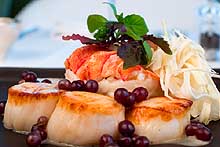Scallops Nutrition Facts

Scallops are a common type of shellfish that are widely consumed in top class restaurants as well as in homes. The shell of the scallop is a distinct, fan shape with a rough, scalloped edge. The part of the scallop that is commonly eaten is the eye, also known as the adductor muscle. However, in certain parts of Europe, the entire scallop is often eaten.
When compared to oysters, the eye, or adductor muscle of the scallop is more developed. The reasoning for this is that scallops are more active swimmers as apposed to oysters.
There are various ways in which to prepare scallops and these include baking in the oven, microwaving, frying or broiling. The key to preparing scallops is in the cooking time, and special care should be taken as to not overcook them. When cooking, as soon as they change from a translucent color and turn opaque, they are about done.
A popular way of cooking scallops, specifically in restaurants, is by sautéing in butter or deep frying in a breaded batter. They are usually accompanied with a light, semi-dry, sweet wine.
Scallops are among the shellfish that cause an allergic reaction to certain people who suffer with these types of allergies.
Six pieces of breaded and fried scallops, weighing approximately 145 grams would contain about 386 calories, 19 grams of fat, 38 grams of carbohydrates and 16 grams of protein. The cholesterol count would be around 108 milligrams, while the sodium count would be around 920 milligrams.
One hundred grams of raw sea scallops would contain around 87 calories, 16.2 grams of protein, 36 milligrams of cholesterol and 87 milligrams of sodium. They also contain 0.8 grams of fat, 0.1 being saturated fat and 0.2 grams being the essential omega-3 fats.
Author: Dimi Ingle
Copyright: Remedium. This article may not be copied, in whole or in part, without the written consent of Remedium.
|